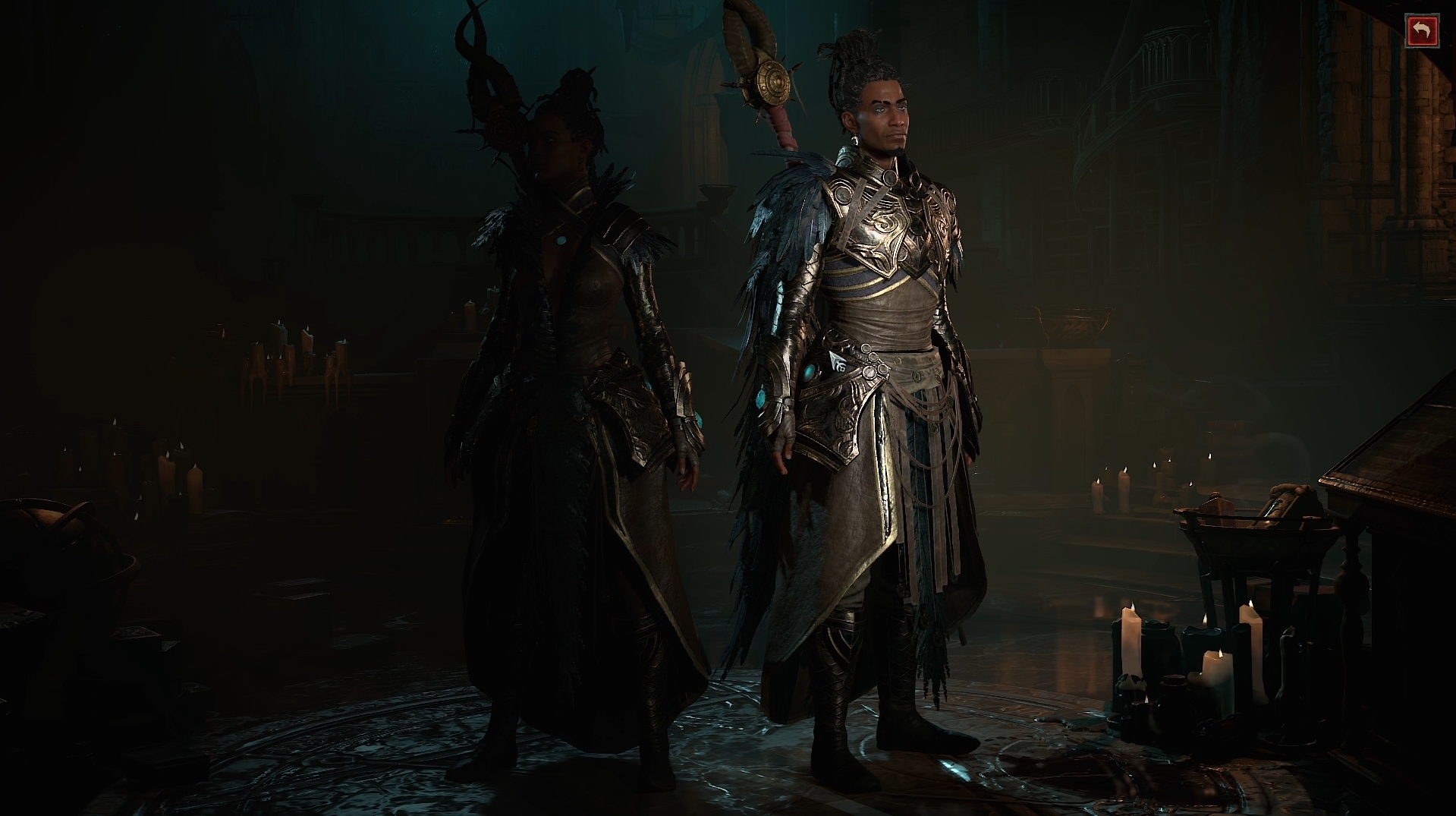Introduction
Diablo 4 is a hack-and-slash action roleplaying game set in a dark fantasy world. In this Diablo 4 beginners guide we will walk you through everything you need to know to assist you in kickstarting your experience in the game.
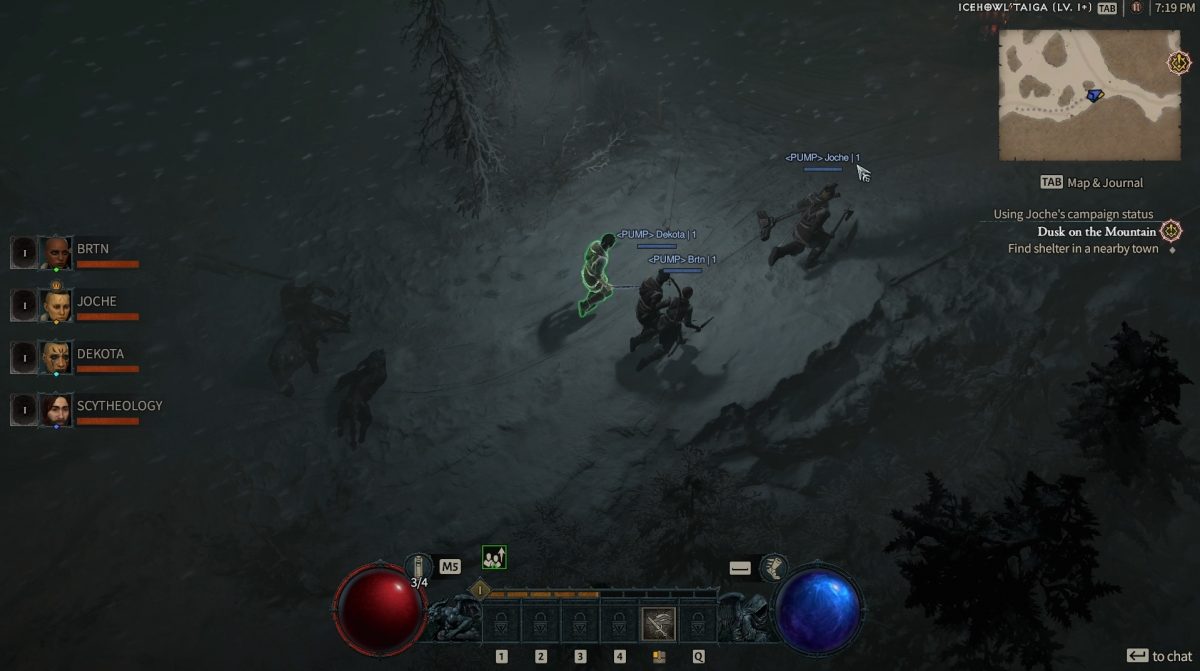
Controls
Most players have their own preferences when it comes to controls and key binds in any game, fortunately, there is a decent amount of customization! Diablo 4 continues the trend of previous Diablo titles with click-to-move functionality. Also alongside the movement are several key binds most players are familiar with, such as “M” for map and so on.
Group play
Grouping with players and friends is fairly easy, and is located in the “Social” tab – accessible by pressing “O”. Here you can also add friends to your friend list. If a player is in close proximity however you can click on them and select to add them to your friend list or to the party and more!
Clans
Clans are a feature in Diablo IV, allowing players with a common interest to gather together and interact! A Clan can participate in various features of the game such as PvP or pushing leaderboards. Ultimately, Clans are a fantastic feature for getting the community together and playing and a welcome addition. You can name, set a motto and change the banner of a Clan.
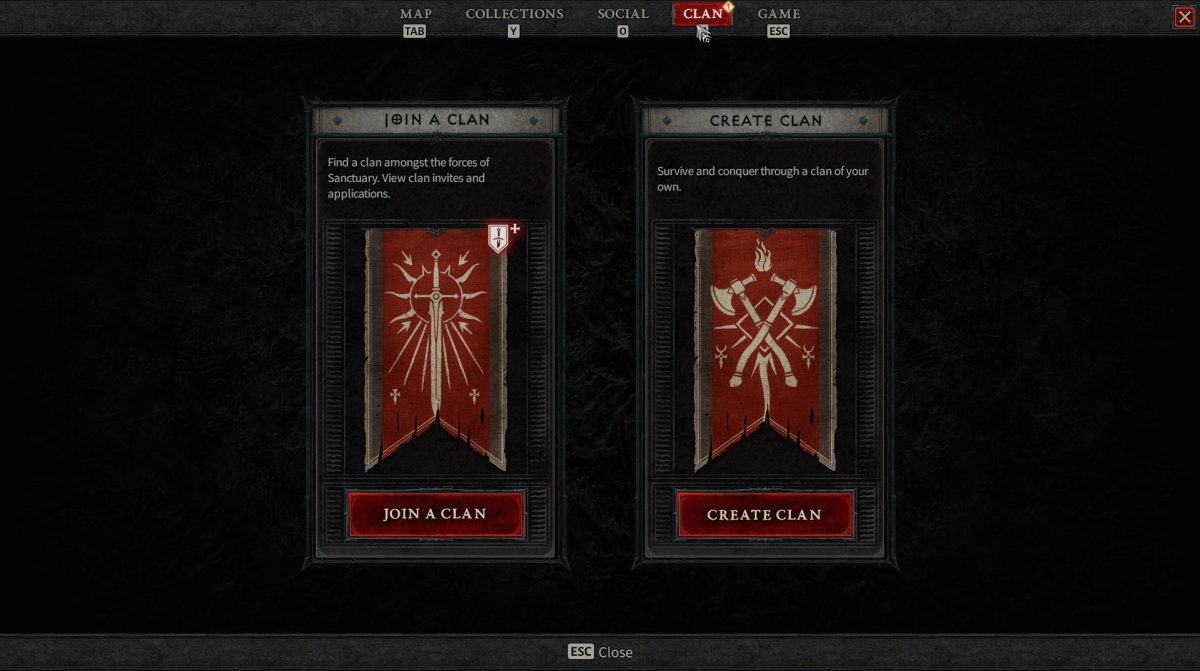
Character Creation
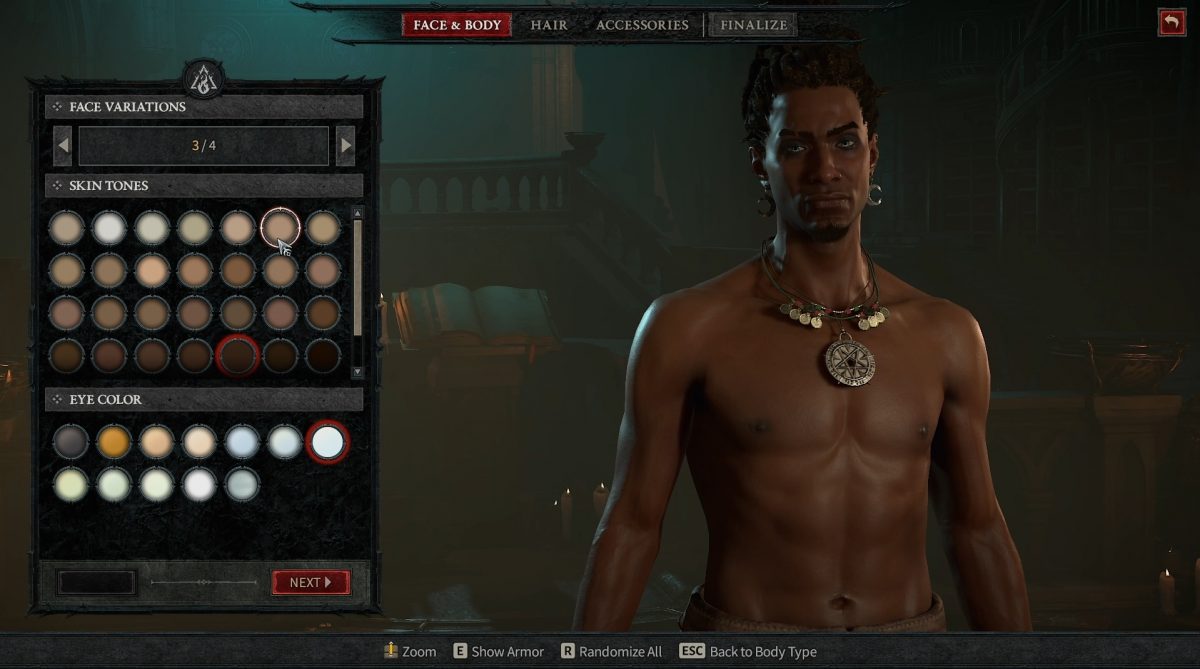
Upon game start, you have the option to select and create a custom character of your choosing. Firstly, the game prompts you to select a class, and from there you can begin customizing. During character customization, you have access to a fair few features as expected in most RPGs.
To start with, the typical facial variation and body variations will be presented to you, this includes skin tones, eye colors and perhaps more in future! Next up, hair fashion! As expected of the hair section, you can change your hair style, facial hair and also colors of each to your own liking.
Finally, the accessories section presents you with various options such as tattoos – known as “markings”, jewelry and make-up options! In the “Finalize” tab, you have the choice of marking your character as “Hardcore”. Essentially this means for the player that if you die, you character is also deleted; death is permanent in this mode so proceed with caution!
Classes
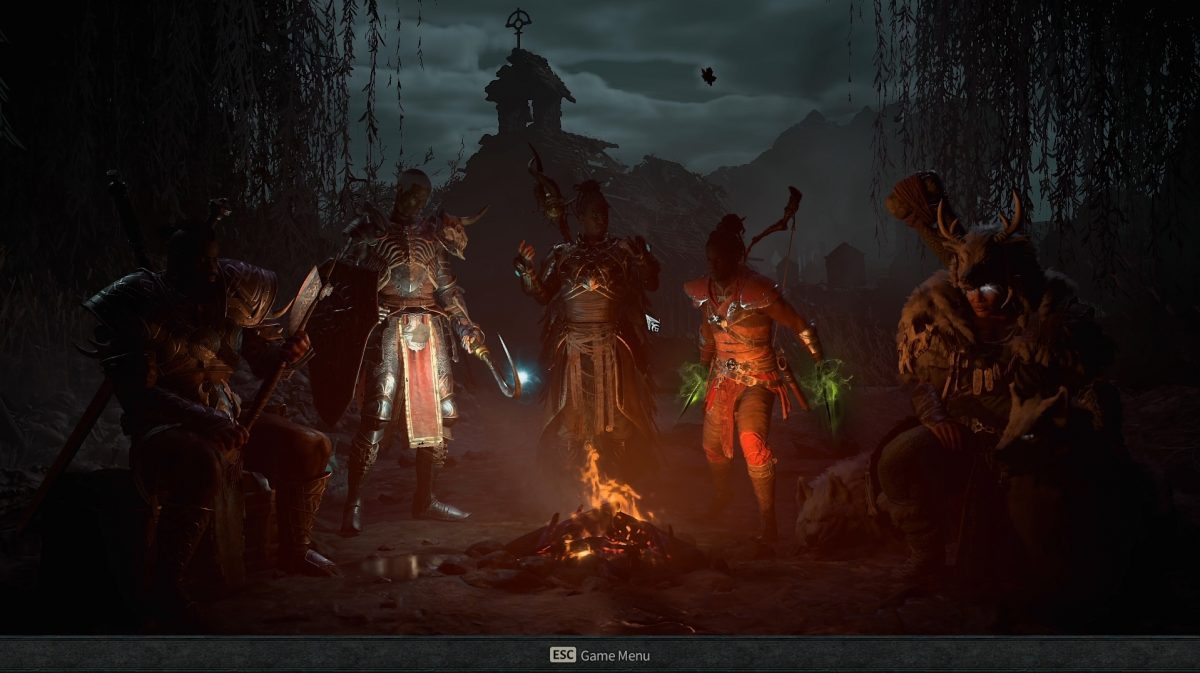
In Diablo 4 there is 5 classes at launch, each of these classes have their own specific mechanics. It should be noted too that you also receive a lot of the mechanics each class plays around fairly early on, giving you a good idea of whether you can enjoy that class or not! This is achieved by completed class-specific quests you receive early on, around level 15+.
Sorcerer
The Sorcerer is your traditional multi-element mage class in the game. Sorcerer is the type of class that allows for massive AoE damage and mayhem, while also having ways to build for single-target bossing. The class also has the ability to use a type of “enchant” system, allowing you to select a couple of spells and enhance them. This is essentially the Sorcerer’s specific mechanic. If you enjoy the traditional mage with many elements to deal with threats, this class is the go-to.
Rogue
The Rogue is the assassin style class of the game. Using weapons such as daggers and bows to deal with targets efficiently and quickly from range or up-close. The main mechanic system with Rogue is the Specialization tab. In the Specialization tab, the Rogue can select from 3 Specializations:
- Combo Points – Your Basic Skills now generate Combo Points. Core Skills consume Combo Points for additional effects
- Inner Sight – Attack marked enemies to fill up your Inner Sight gauge. When it’s full, gain Unlimited Energy for 4 seconds
- Preparation – Shaving off cooldowns to perform big powerplay moments
Barbarian
The Barbarian is the world renowned melee warrior you know and love. Barbarian utilizes several weapons to deal damage and versatile ways. The main feature the class wields is the Expertise system, allowing you to level up and also “master” various weapon types. Depending on which weapon you have equipped and “master”, your Barbarian gains bonuses based on that weapon and even weapon techniques.
Druid
The Druid is a hybrid class, sitting between a caster mage and a shapeshifter based deep in nature itself. The class can take several forms of wild beasts and as a result, has various playstyles and strengths. The main unique mechanic the Druid possesses is their “Spirit Boons”. Spirit Boons gives a Druid access to various spirit animals, increasing their power and perks via passives – unlockable by offering “Druidic Offerings” that drop on mob kills.
Necromancer
The Necromancer is a very popular class in the Diablo franchise. As players can expect, the Necromancer is a mage caster based around dark magic spells and controlling the undead. As a result, the class can play various playstyles, with the Necromancer being at the forefront of the gameplay, or an undead army fighting for you. The main unique mechanic the class has available to it is the “Book of the Dead”. Essentially, the Book of the Dead allows the player to select what types of undead you can summon, and the buffs they provide. Failing that however, you also have the choice to select no minions and gain powers for yourself.
Difficulty
Difficulty in Diablo is a mainstay within the franchise and Diablo 4 is no exception. The general premise is to climb higher up the difficulty ranks known as “World Tiers” and gain more power. The difficulty overview is as follows:
- Adventurer
- Veteran
- Nightmare
- Torment
When creating a new character however, only Adventurer and Veteran are available to you. Moving up in difficulty provides a more challenging world with tougher mobs, but also rewards you with more loot.
Leveling
Leveling in Diablo 4 is only the beginning of your adventure. Progressing through the main quest line, completing side quests and also dynamic world events all contribute towards XP gain and leveling your character. Playing with friends has its benefits too, due to the fact that having friends with you also increases your XP gain! Each level you gain on your character provides you with Skill Points, allowing you the ability to upgrade and learn new spells or passives.
Hitting specific character level thresholds and moments in the main campaign helps unlock the additional World Tiers as you level.
Finally, one key aspect of Diablo as a franchise however, is that your journey doesn’t end at level cap. Instead, your character is forever evolving and growing in power through the Paragon system – a huge part of the Endgame.
Gear
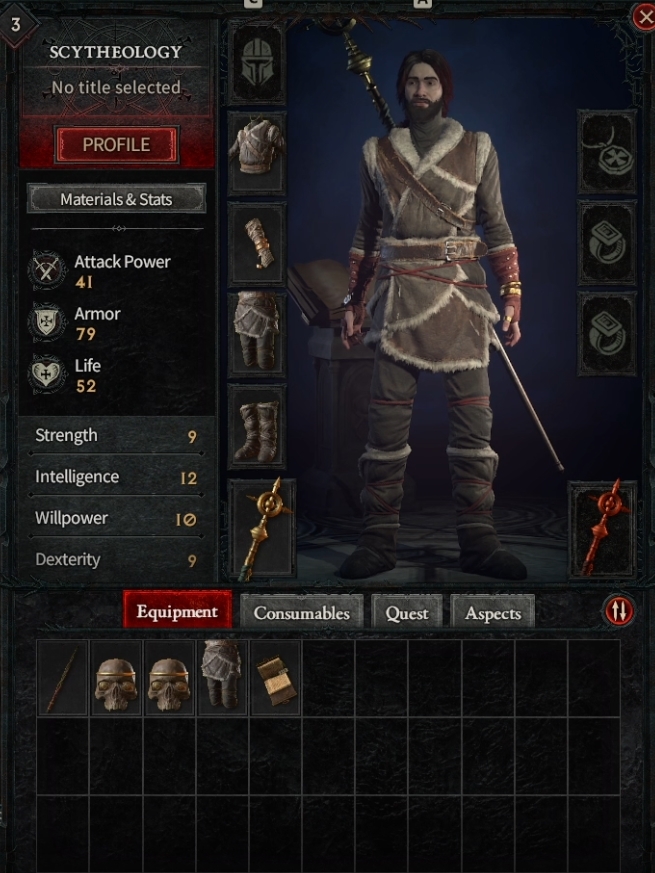
Gear in Diablo 4 is split into several slots to equip them to:
- Helmet
- Gloves
- Chest
- Legs
- Boots
- Main-hand weapon
- Off-hand weapon
- Ring 1
- Ring 2
- Amulet
Throughout your game experience, finding and equipping the most optimized pieces for your build is key, look through the loot you receive!
Stats
Stats in Diablo 4 are split into Core stats, Utility stats, Offensive stats and Defensives stats. Core stats provide the traditional stats we are all familiar with:
- Strength – +1 Armor per point
- Intelligence – +0.05% All Resistance per point
- Willpower – +0.1% Healing Received and +0.25% Overpower Damage per point
- Dexterity – +0.025% Dodge Change per point
The other stat types, such as offensive and defensive stats provide many familiar stats. A good example of this, are stats such as Attack Speed, Critical Strike Chance, Max Life and more.
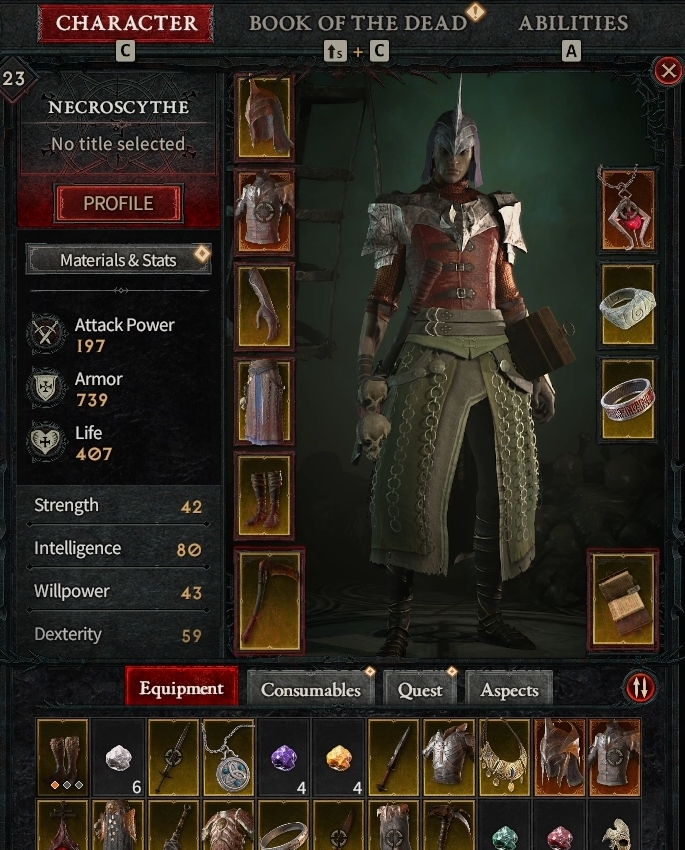
Skill Trees
Each class has its own access to a vast amount of active and passive skills. These are unlocked by using Skill Points that you receive through leveling up and completing Renown milestones. Your class build can vary massively based on where you commit your points. The skills are put into various clusters:
- Basic – all Basic skills and upgrade paths, your low cost primary resource generators
- Core – Core skills, upgrades and passive. These are your more iconic and raw damage dealing skills and use the resources you generate with Basic skills
- Unique – These are the skills and passives where you receive more complexities in your gameplay patterns
- Ultimate – This cluster you receive an Ultimate skill with upgrades and passives. These are the longest cooldown spells a class will have and are a one-of
- Passives – This last section contains very powerful passives, however you can only select one much like the Ultimate skill

Challenges
The challenge system also makes an appearance in Diablo 4. Challenges follow the similar style in most games of setting you goals and also rewarding you for reaching them. There is also a lot of challenges to complete, as a result, there is a lot of free rewards to obtain, or objectives for completionists to chase! There are several challenge categories:
- Summary
- Classes
- Crafting
- Challenge
- Exploration
- Hardcore
- Monsters
- Multiplayer
- Open World
- Quests
- Feats of Strength
Renown
In Diablo 4, there are 5 major regions of the map. Each region however is covered by the Renown system. Renown is a system that ties many activities in the game world to a region, giving you additional rewards. This system is measured using a points system, each activity in one of the 5 regions award points to that region based on the activity completed. Renown is without a doubt a beautiful feature for completionists! Finally, players should keep in mind that the rewards such as “1 Potion Charge” or “1 Skill Points” are account bound and apply to all your characters. However, the gold and XP are class specific!
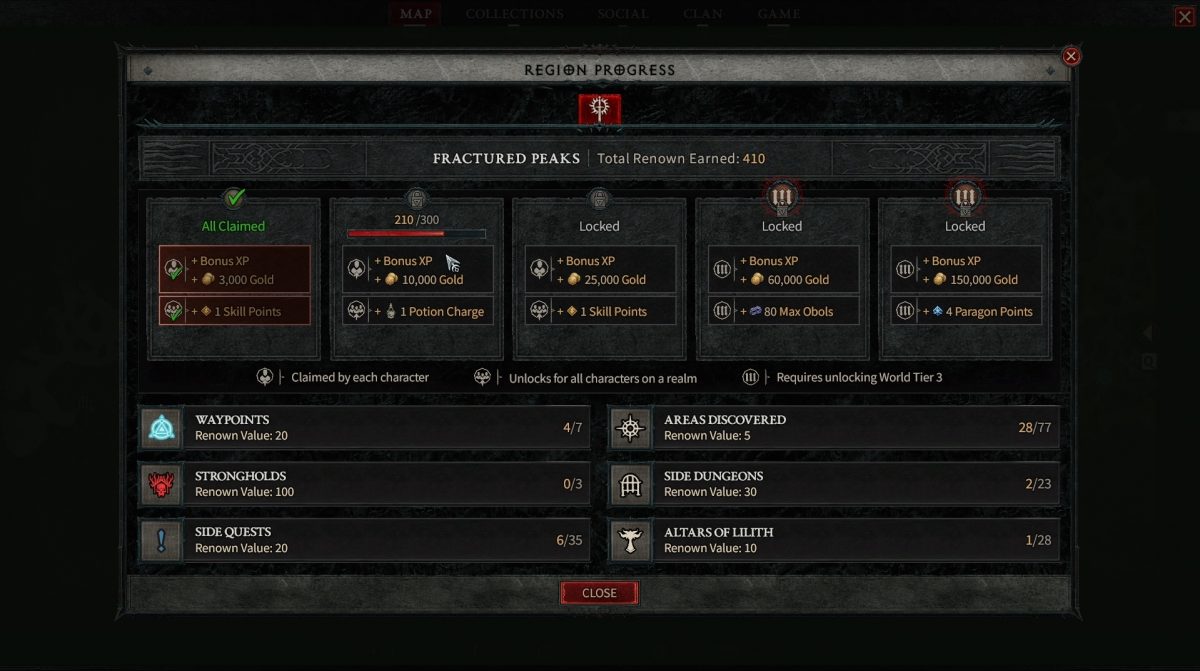
Map

The map in Diablo 4 is accessible by pressing “M”. There are 5 major regions of the map:
- Kehjistan
- Scosglen
- The Dry Steppes
- The Fractured Peaks
- Swamplands of Hawezar
Using the map, navigating should be a breeze, with the ability to fast travel on unlock waypoints, available on the map.
Town NPC Vendors
NPC Vendors are a key feature of any fantasy game. Each NPC within a city or town have a very distinct and important role to play for you in your adventure:
- Blacksmith – Repairs damaged or broken gear, salvage items, upgrade gear such as weapons and armor
- Jeweler – Craft gems or upgrades here, also add sockets to gear and upgrade jewelry
- Alchemist – Upgrades health potions, refine resources and craft elixirs or other consumables
- Occultist – Allows you to extract and imprint various legendary powers from your “Aspect Codex”
- Purveyor of Curiosities – The gambler NPC, use currencies received from zone events in the open world to roll random gear
Open World Events
Open World or Zone Events occur all throughout the open zones of Diablo 4. There are a couple of indicators both in the close proximity and on the map showing when an event is starting or happening. The zone events are random but from a select list of events. Completing these events awards you with gold, XP, gear and most importantly, the currency “Obols” – allowing you to also be able to gamble for good gear.
World Bosses
Another fantastic aspect of Diablo 4 is the arrival of catastrophe-class World Bosses. These World Bosses arrival only at specific times and places and provide a very tough challenge, requiring everyone in the nearby area to slay it. The players participating are tasked with killing the boss within a time limit, breaking through HP checkpoints. Slaying these bosses provides you with fantastic rewards and are almost always worth doing!
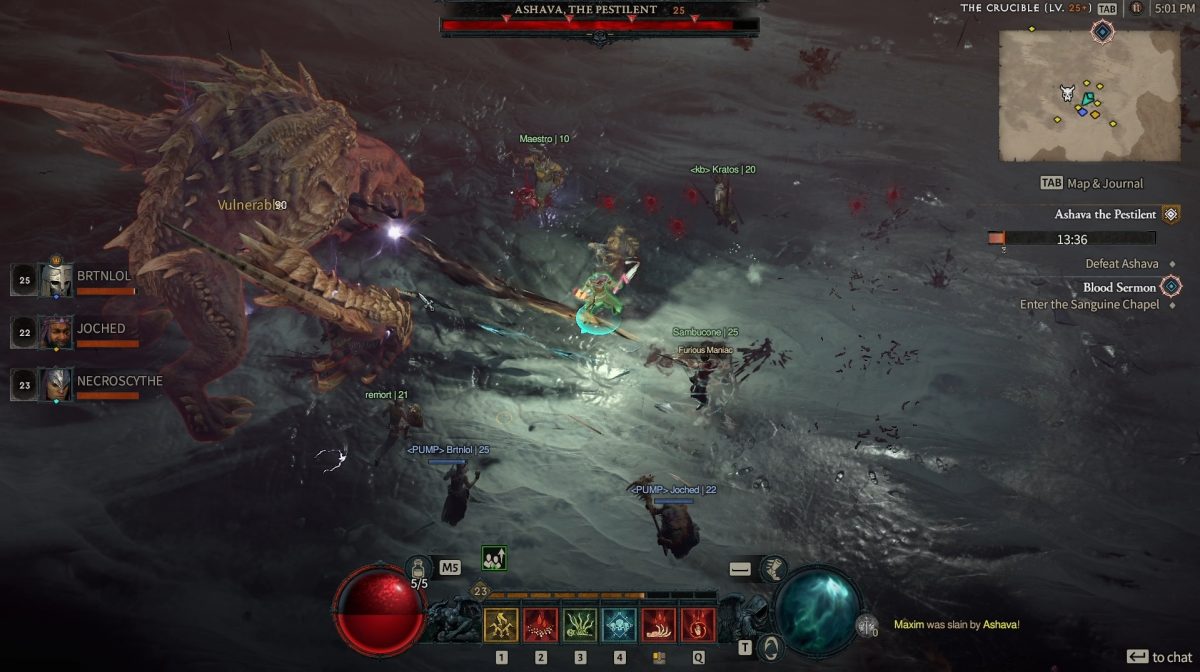
PvP – Fields of Hatred
This time around, PvP has been more than an afterthought in Diablo, as a result, PvP now has its own place and mechanics! The Fields of Hatred are zones throughout the regions in Diablo 4 that also enable PvP. While in the zones, killing players and generally participating also provides you with a Shard currency. However, to leave the Fields of Hatred with this new premium currency, you must purify your Shards at an alter – this alter alerts ALL players that you are doing this; prepare for combat. Finally, once you have successfully extracted the Shards, you can use the currency to purchase items.
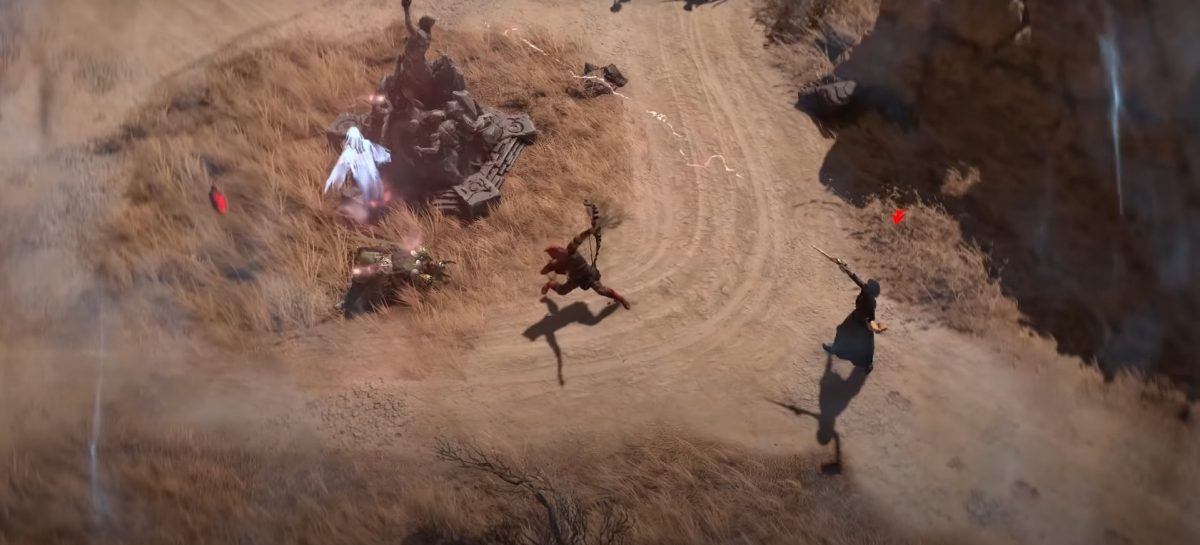
Dungeons
Dungeons, much like previous Diablo titles are randomized and with more features than before for you to experience however. Currently, over 150 dungeons are in Diablo 4 – some being tied to the main quest line and also the side quests. In typical fashion, dungeons also provide you with vast amounts of currencies, XP and loot. However, most dungeons are their own “mini-story”. Finally, in the open world, there are Strongholds that when completed, can even become dungeons themselves!
Strongholds
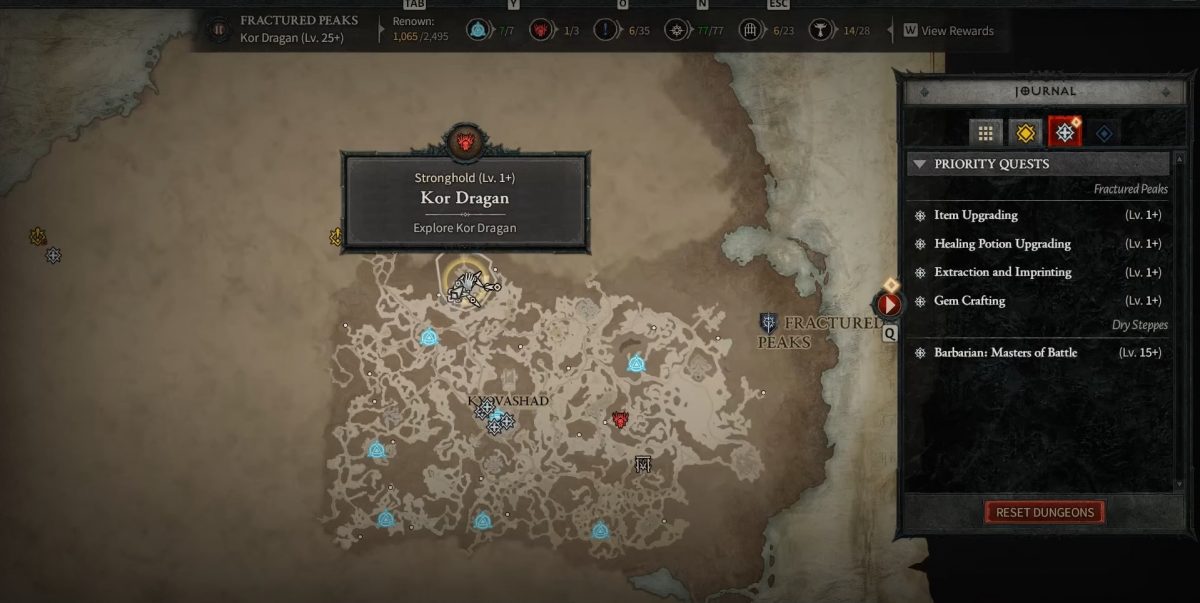
Strongholds are occupied locations on the map held by the demons. At the Strongholds, players must also clear them out by completing any unique objectives, puzzles or boss kills. You only have to clear a Stronghold once, as it never returns once completed for the first time. Completing Strongholds awards you with a healthy amount of Renown, and also unlocks a new public space. The following outcomes are all possible:
- A Legion Event is revealed (more challenging zone event)
- A waypoint also spawns
- A shortcut is unlocked as a result
- The Stronghold reveals side quests
- A dungeon is formed in place of the Stronghold
- The Stronghold also becomes a town hub
Altars of Lilith
The Altars of Lilith are small altars found around the map of Diablo 4. Interacting with an Altar provides the player with a boost in Core Stats. We recommend keeping on the lookout for these Altars!
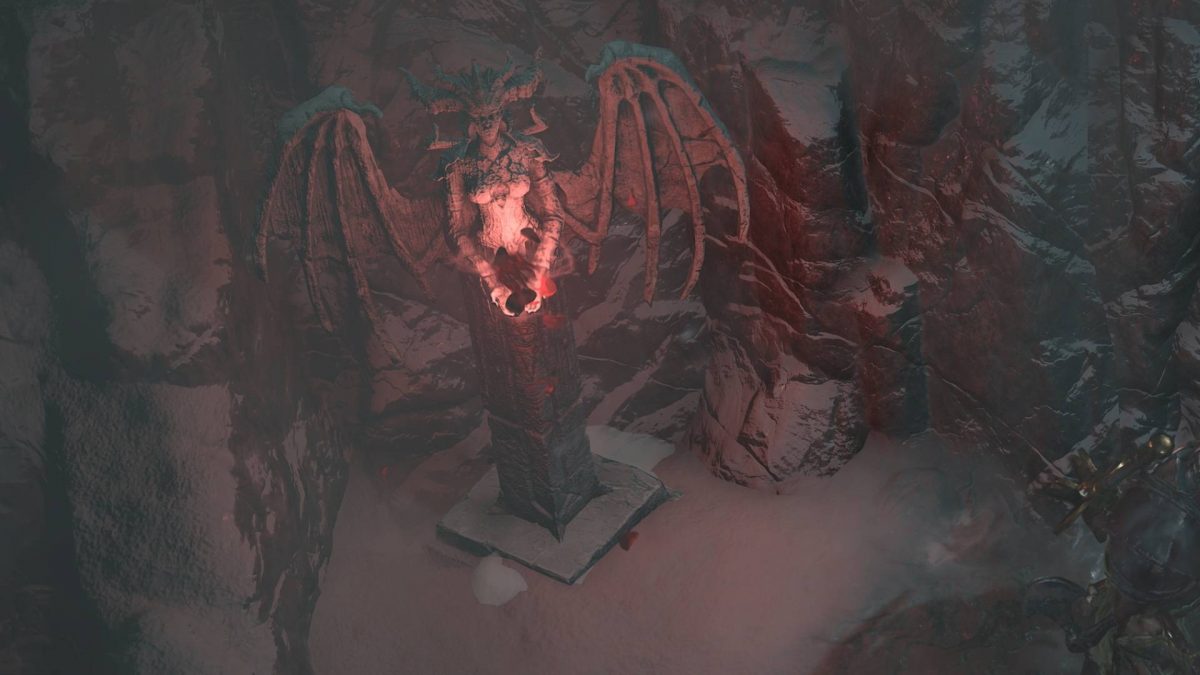
Endgame
After you complete the main quest line and follow it the entire way through your leveling experience, the Endgame also begins. Many new major elements become available to you at this point of the game and also provide new challenges. To read more on what the endgame also has to offer – check out our Endgame post.
Conclusion
And that also concludes our Diablo 4 beginners guide! We hope this can help many new players or also even returning players to kickstart their Diablo adventures! Check out our Diablo 4 section for many more future in-depth and also important guides and updates!

